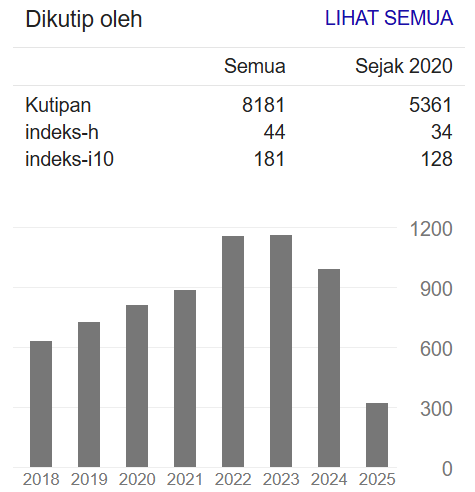MODEL STRUKTURAL SISTEM INFORMASI MANAJEMEN RUMAH SAKIT BERDASARKAN FRAMEWORK HOT-FIT MODEL
DOI:
https://doi.org/10.34011/jmp2k.v35i2.2537Keywords:
hot-fit framework, SEM-PLS, HMIS, technologyAbstract
Hospital Management Information Sistem (HMIS) aims to enhance operational efficiency and healthcare service quality through the integration of patient data, electronic medical records, and resource management. However, its implementation in many hospitals is still hindered by infrastructure limitations, human resource readiness, and sistem interoperability, preventing optimal functionality. Strengthening policies, enhancing human resource capacity, and technological support are essential for effective HMIS implementation. This study aims to develop a structural model of HMIS based on the HOT-fit framework. A quantitative research approach with a cross-sectional design was employed. The study population comprised professionals (doctors, nurses, administrative staff) whose involvement with HMIS met the inclusion criteria, totaling 56 participants. The questionnaire used was validated for reliability and validity. Data were analyzed using SEM-PLS4 for students. The results indicate that service and technology quality significantly impact HMIS effectiveness, providing a basis for hospital management to improve human resource training and technological investment. The HOT-fit framework integrates Human, Organization, and Technology elements to assess the alignment of information sistems with organizational needs. Indirect effects were found, showing that the relationship between human and organizational factors on benefits is mediated by technology. The structural model of HMIS, based on the HOT-fit framework, achieved an SRMR value of 0.073 (<0.08), indicating a good model fit. The study concludes that the structural model of HMIS based on the HOT-fit framework provides a validated approach to improving sistem implementation in hospitals. Future research could focus on evaluating this model across various hospital settings to ensure broader applicability
References
P. W. Handayani dkk, Pengantar Sistem Informasi Manajemen Rumah Sakit (SIMRS), Ke-1. Jakarta, 2018.
N. Muthia and A. Pratiwi, “Implementasi Teknologi Kesehatan untuk Meningkatkan Efisiensi dan Kualitas Pepelayanan : Perspektif SDM Kesehatan Implementasi Teknologi Kesehatan untuk Meningkatkan Efisiensi dan Kualitas Pepelayanan : Perspektif SDM Kesehatan,” no. December, 2023.
E. Oktaviana, W. H. N. Putra, and A. Rachmadi, “Evaluasi Sistem Informasi Manajemen Rumah Sakit (SIMRS) RSUD Gambiran Kediri menggunakan Framework Human, Organization, and Technology-Fit (HOT-FIT) Model,” Jurnal Pengembangan Teknologi Informasi dan Ilmu Komputer, vol. 6, no. 4, pp. 1779–1788, 2022.
Kemenkumham RI, “Peraturan Pemerintah RI No 47 Tahun 2021 Tentang Penyelenggaraan Bidang Perumahsakitan,” 2021.
A. N. Maghfiroh, “Kewajiban Rumah Sakit dalam Memberikan Pepelayanan yang Baik kepada Pasien.” Accessed: Jun. 24, 2023. [Online]. Available: https://heylaw.id/blog/kewajiban-rumah-sakit-dalam-memberikan-pepelayanan
Kemenkes RI, Permenkes RI Nomor 82 Tahun 2013 Tentang Sistem Informasi Manajemen Rumah Sakit. 2013.
S. M. Puspitasari and W. Istiono, “Penilaian Manfaat Sistem Informasi Manajemen Rumah Sakit ( SIMRS ) Terhadap Individu dan Organisasi dengan Model Delone dan McLean pada RSUD dr . Hardjono,” Journal of Information Systems for Public Health, vol. 2, no. 3, 2017.
R. K. Prasetyowati, Asih, “Pengaruh Faktor Hot (Human, Organisasi, Dan Teknologi) Terhadap Kepuasan Pengguna Sistem Informasi Primary Care Di Wilayah Kota Semarang,” JurnalMIKI, vol. 6, no. 1, pp. 63–69, Mar. 2018, https://doi.org/10.33560/jmiki.v6i1.188.
W. H. DeLone and E. R. McLean, “The DeLone and McLean model of information sistems success: A ten-year update,” Journal of Management Information Sistems, vol. 19, no. 4, pp. 9–30, 2003, doi: 10.1080/07421222.2003.11045748.
M. M. Yusof, J. Kuljis, A. Papazafeiropoulou, and L. K. Stergioulas, “An evaluation framework for Health Information Sistems: human, organization and technology-fit factors (HOT-fit),” Int J Med Inform, vol. 77, no. 6, pp. 386–398, 2008, doi: 10.1016/j.ijmedinf.2007.08.011.
K. M. Susilo, Beny Binarto Budi, “Evaluasi Penerapan Sistem Informasi Manajemen Rumah Sakit ( SIMRS ) di RSUD Praya Kabupaten Lombok Tengah Nusa Tenggara Barat,” Journal of Information Systems for Public Health, vol. 4, no. 1, pp. 1–15, 2019.
Aviat, “22% RS di Indonesia Belum Menggunakan SIMRS Sama Sekali,” 2023. https://aviat.id/22-rs-di-indonesia-belum-menggunakan-simrs-sama-sekali%EF%BF%BC/
Salmiati, J. Harahap, and D. Theo, “Faktor-Faktor Yang Memengaruhi Implementasi Sistem Informasi Manajemen Rumah Sakit Di RS. Nurul Hasanah Aceh Tenggara,” Jurnal Kesehatan dan Fisioterapi (Jurnal KeFis), vol. 3, no. 1, pp. 10–16, 2023.
A. Faigayanti, L. Suryani, H. Rawalilah, P. Studi, and M. Kesehatan, “Evaluasi Sistem Informasi Manajemen Rumah Sakit ( SIMRS ) di Bagian Rawat Jalan dengan Metode HOT -Fit,” Jurnal Kesehatan Saelmakers PERDANA, vol. 5, no. 2, 2022, doi: 10.32524/jksp.v5i2.662.
E. R. Puspitasari and E. Nugroho, “Evaluasi implementasi sistem informasi manajemen rumah sakit di rsud kabupaten temanggung dengan menggunakan metode hot-fit,” Journal of Information Sistems for Public Health, vol. 5, no. 3, p. 45, 2021, doi: 10.22146/jisph.37562.
A. Khotimah and L. Lazuardi, “Evaluasi Sistem Informasi Manajemen Rumah Sakit Rajawali Citra Yogyakarta Menggunakan Model Human Organization Technology Fit (HOT-Fit),” Journal of Information Sistems for Public Health, vol. 3, no. 2, pp. 19–26, 2018.
RSAU dr Sukirman, “Profil RSAU dr Sukirman Kota Pekanbaru,” Pekanbaru, 2023.
J. F. Hair, M. C. Howard, and C. Nitzl, “Assessing measurement model quality in PLS-SEM using con fi rmatory composite analysis,” J Bus Res, vol. 109, no. August 2019, pp. 101–110, 2020, doi: 10.1016/j.jbusres.2019.11.069.
P. Jogiyanto HM, Konsep Dan Aplikasi Structural Equation Modeling Berbasis Varian Dalam Penelitian Bisnis, Pertama. Yogyakarta: STIM YKPN Yogyakarta, 2011.
S. Yamin, SMARTPLS 3 SMARTPLS 4, Ketiga. Depok, 2023.
F. Santoso and Y. S. Salma, “Model HOT Fit Dalam Manajemen Sistem Informasi,” Manajemen Sistem Informasi. Bincang Sains Dan Teknologi, vol. 1, no. 02, pp. 76–82, 2022, doi: 10.56741/bst.v1i02.144.
Z. Yue, Y. Zhenghong, Q. Zhang, W. Qin, Y. Chun, and Y. Zhang, “Transition to a new nursing information sistem embedded with clinical decision support : a mixed method study using the HOT fit framework,” BMC Med Inform Decis Mak, pp. 1–20, 2022, doi: 10.1186/s12911-022-02041-y.
A. D. Putra, M. S. Dangnga, and M. Majid, “Evaluasi SIMRS Dengan Metode HOT FIT DI RSUD Andi Makkasau Kota Parepare,” Jurnal Ilmiah Manusia Dan Kesehatan, vol. 1, no. 1, 2020.
D. Makalalag, F. Agushybana, and A. Mawarni, “Evaluasi Sistem Informasi Pepelayanan Rekam Medis di RSJ Prof . Dr . V . L . Ratumbuysang Provinsi Sulawesi Utara dengan Pendekatan Hot Fit Model,” Jurnal Manajemen Kesehatan Indonesia, vol. 5, no. 2, pp. 82-93, Aug. 2017. https://doi.org/10.14710/jmki.5.2.2017.82-93.
I. B. Sukma, Chandra, “Penerapan Metode HOT Fit Dalam Evaluasi Ssistem Informasi Manajemen Rumah Sakit Di RSUD Jombang,” Jurnal Informasi dan Komputer, vol. 5, no. 1, 2017.




